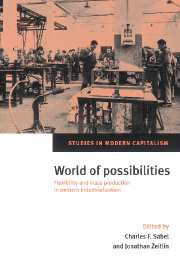Book contents
- Frontmatter
- Contents
- List of contributors
- Acknowledgments
- Stories, strategies, structures: rethinking historical alternatives to mass production
- Part I The modernity of tradition
- 1 Fashion as flexible production: the strategies of the Lyons silk merchants in the eighteenth century
- 2 The fate of collective manufactures in the industrial world: the silk industries of Lyons and London, 1800–1850
- 3 The rise and decline of flexible production: the cutlery industry of Solingen since the eighteenth century
- 4 Manufacturing flexibility in nineteenth-century Switzerland: social and institutional foundations of decline and revival in calico-printing and watchmaking
- Part II The battle of the systems
- Part III The resurgence of flexible production
- Index
4 - Manufacturing flexibility in nineteenth-century Switzerland: social and institutional foundations of decline and revival in calico-printing and watchmaking
Published online by Cambridge University Press: 12 December 2009
- Frontmatter
- Contents
- List of contributors
- Acknowledgments
- Stories, strategies, structures: rethinking historical alternatives to mass production
- Part I The modernity of tradition
- 1 Fashion as flexible production: the strategies of the Lyons silk merchants in the eighteenth century
- 2 The fate of collective manufactures in the industrial world: the silk industries of Lyons and London, 1800–1850
- 3 The rise and decline of flexible production: the cutlery industry of Solingen since the eighteenth century
- 4 Manufacturing flexibility in nineteenth-century Switzerland: social and institutional foundations of decline and revival in calico-printing and watchmaking
- Part II The battle of the systems
- Part III The resurgence of flexible production
- Index
Summary
Introduction: the Swiss experience of industrialization –a flexible craft alternative
Technical challenges and response strategies
There were two particular phases in the nineteenth-century Western industrialization process when the force of international competition and the impact of new technologies threw Swiss manufacturing milieux into disarray. The first phase was the surge of British industrialization at the beginning of the nineteenth century: the Manchester effect or the challenge of relatively standardized mechanized production of intermediate products like cotton yarn or certain finished products like printed fabrics. The second was the emergence in the last quarter of the nineteenth century of the “American system of manufactures” whose originality lay in perfecting the standardization of the semi-product, or progressing towards the interchangeability of components so as to make possible standardized fabrication of the finished product.
These important changes in production techniques and the forms of industrial organization linked to them met with a variety of responses in Switzerland: some saw in them the key to progress while others saw these foreign models as destructive of craft traditions and incompatible with the specific requirements of Helvetic industrial production.
Responses to these challenges were ambivalent. In the cotton industry at the start of the nineteenth century the Swiss spinning sections – which became an arena for intense experimentation with advanced technologies – did not imitate the English model blindly. While adopting those new techniques from abroad that had proved their effectiveness elsewhere, the country's spinners adapted English prototypes (or machines of French construction that were easier to import) to the specific needs of the domestic market – i.e. to the extremely diverse needs of sectors further on in the manufacturing chain (indigenous weaving of numerous specialities).
- Type
- Chapter
- Information
- World of PossibilitiesFlexibility and Mass Production in Western Industrialization, pp. 188 - 238Publisher: Cambridge University PressPrint publication year: 1997
- 4
- Cited by



